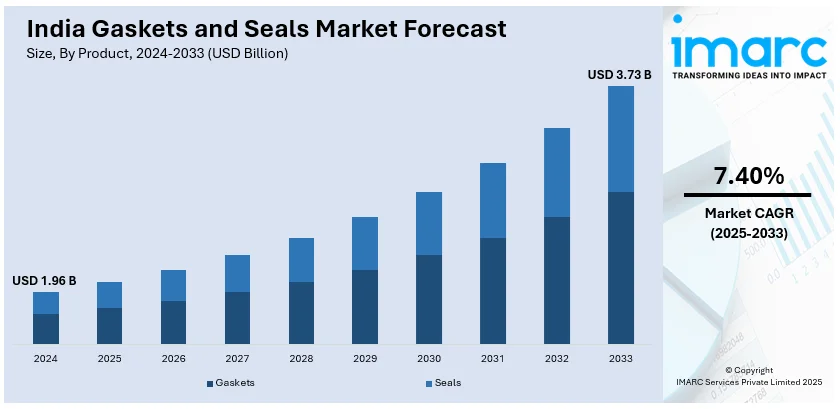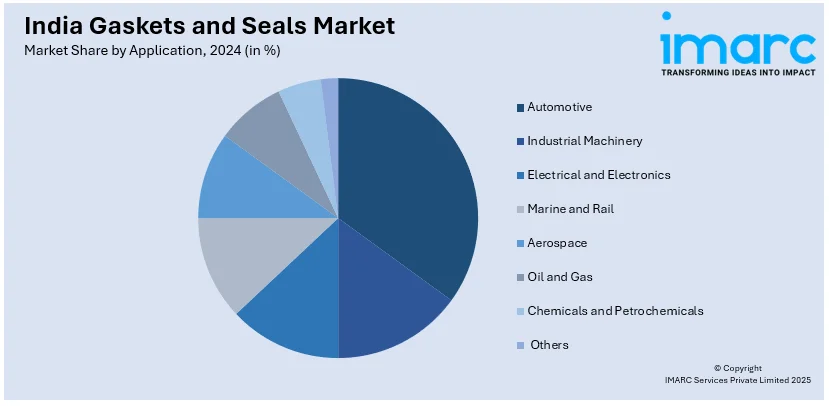
India Gaskets and Seals Market Size, Share, Trends and Forecast by Product, Material, Application, End Use, and Region, 2025-2033
India Gaskets and Seals Market Size and Share:
The India gaskets and seals market size reached USD 1.96 Billion in 2024. Looking forward, IMARC Group expects the market to reach USD 3.73 Billion by 2033, exhibiting a growth rate (CAGR) of 7.40% during 2025-2033. The India gaskets and seals market growth is driven by rapid industrialization, growing automotive production, rising demand in oil and gas, chemical, and manufacturing industries, stringent emission regulations, expanding infrastructure projects, advancements in material technology, and the need for high-performance sealing solutions.
|
Report Attribute
|
Key Statistics
|
|---|---|
|
Base Year
|
2024
|
|
Forecast Years
|
2025-2033
|
|
Historical Years
|
2019-2024
|
| Market Size in 2024 | USD 1.96 Billion |
| Market Forecast in 2033 | USD 3.73 Billion |
| Market Growth Rate (2025-2033) | 7.40% |
India Gaskets and Seals Market Trends:
Rising Demand from Automotive and Industrial Sectors
The India gasket and seals market share is witnessing significant expansion due to increasing demand from the automotive and industrial machinery sectors. The rapid expansion of the automotive industry, driven by rising vehicle production and stringent emission regulations, is fueling the need for high-performance sealing solutions. Notably, on January 17, 2025, Prime Minister Narendra Modi formally opened the Bharat Mobility Global Expo 2025 at Bharat Mandapam in New Delhi. He cited India's automobile industry's 12% growth over the past 12 months, with yearly sales of over 2.5 crore vehicles. Additionally, the growth of industrial manufacturing, power generation, and heavy machinery is boosting demand for durable and efficient gaskets and seals. The adoption of advanced materials such as PTFE, rubber, and non-asbestos composites further supports market expansion. With increasing investments in infrastructure and technological advancements, the market is poised for steady growth in the coming years.

To get more information on this market, Request Sample
Advancements in Material Technology and Sustainability
Material advancements are defining positive India gasket and seals market outlook with high-performance and environment-friendly material developments by manufacturers. The transition towards non-asbestos gaskets, fiber-reinforced composites, and silicone-based seals is becoming more prominent due to improved durability and environmental compatibility. Furthermore, the sustainability drive has accelerated research in recyclable and biodegradable sealing solutions. With oil and gas, chemical, and aerospace industries requiring stronger heat- and pressure-resistant products, advances in polymer and metal gasket technologies are propelling the market's growth. As industries focus on energy efficiency, emission control is favorably contributing to the India gasket and seals market trend. Additionally, stringent government laws regarding emissions and workplace safety are leading industries to embrace sealing solutions that improve operating efficiency and lower environmental footprints. The increased usage of electric vehicles (EVs) and advances in automobile sealing technology are also driving the demand for high-temperature-resistant lightweight materials. Technological advancements in nanotechnology and intelligent sealing materials, with self-healing and adaptive characteristics, are likely to drive the industry's future, enabling longer product life and cost savings. As industries focus on energy efficiency and emission reduction, these technologies are contributing positively towards the overall development of the market.
India Gaskets and Seals Market Segmentation:
IMARC Group provides an analysis of the key trends in each segment of the market, along with forecasts at the country level for 2025-2033. Our report has categorized the market based on product, material, application, and end use.
Product Insights:
- Gaskets
- Metallic Gasket
- Rubber Gasket
- Cork Gasket
- Non-Asbestos Gasket
- Spiral Wound Gasket
- Others
- Seals
- Shaft Seals
- Molded Seals
- Motor Vehicle Body Seals
- Others
The report has provided a detailed breakup and analysis of the market based on the product. This includes gaskets (metallic gasket, rubber gasket, cork gasket, non-asbestos gasket, spiral wound gasket, and others) and seals (shaft seals, molded seals, motor vehicle body seals, and others).
Material Insights:
- Fiber
- Graphite
- PTFE
- Rubber
- Silicones
- Others
A detailed breakup and analysis of the market based on the material have also been provided in the report. This includes fiber, graphite, PTFE, rubber, silicones, and others.
Application Insights:

- Automotive
- Industrial Machinery
- Electrical and Electronics
- Marine and Rail
- Aerospace
- Oil and Gas
- Chemicals and Petrochemicals
- Others
A detailed breakup and analysis of the market based on the application have also been provided in the report. This includes automotive, industrial machinery, electrical and electronics, marine and rail, aerospace, oil and gas, chemicals and petrochemicals, and others.
End Use Insights:
- OEM
- Aftermarket
A detailed breakup and analysis of the market based on the end use have also been provided in the report. This includes OEM and aftermarket.
Regional Insights:
- North India
- South India
- East India
- West India
The report has also provided a comprehensive analysis of all the major regional markets, which include North India, South India, East India, and West India.
Competitive Landscape:
The market research report has also provided a comprehensive analysis of the competitive landscape. Competitive analysis such as market structure, key player positioning, top winning strategies, competitive dashboard, and company evaluation quadrant has been covered in the report. Also, detailed profiles of all major companies have been provided.
India Gaskets and Seals Market News:
- 20 March 2024: ARLANXEO, a global leader in performance elastomers, presented its sustainable and innovative rubber solutions at the India Rubber Expo 2024, demonstrating its commitment to the Indian and Asia Pacific markets. The company showcased its expanded Keltan® Eco portfolio, featuring bio-circular products and its existing bio-based grades derived from sugarcane. Keltan® EPDM is extensively used in eco-friendly automotive components, including seals, gaskets and hoses, for thermal management systems.
India Gaskets and Seals Market Report Coverage:
| Report Features | Details |
|---|---|
| Base Year of the Analysis | 2024 |
| Historical Period | 2019-2024 |
| Forecast Period | 2025-2033 |
| Units | Billion USD |
| Scope of the Report |
Exploration of Historical Trends and Market Outlook, Industry Catalysts and Challenges, Segment-Wise Historical and Future Market Assessment:
|
| Products Covered |
|
| Materials Covered | Fiber, Graphite, PTFE, Rubber, Silicones, Others |
| Applications Covered | Automotive, Industrial Machinery, Electrical and Electronics, Marine and Rail, Aerospace, Oil and Gas, Chemicals and Petrochemicals, Others |
| End Uses Covered | OEM, Aftermarket |
| Regions Covered | North India, South India, East India, West India |
| Customization Scope | 10% Free Customization |
| Post-Sale Analyst Support | 10-12 Weeks |
| Delivery Format | PDF and Excel through Email (We can also provide the editable version of the report in PPT/Word format on special request) |
Key Questions Answered in This Report:
- How has the India gaskets and seals market performed so far and how will it perform in the coming years?
- What is the breakup of the India gaskets and seals market on the basis of product?
- What is the breakup of the India gaskets and seals market on the basis of material?
- What is the breakup of the India gaskets and seals market on the basis of application?
- What is the breakup of the India gaskets and seals market on the basis of end use?
- What is the breakup of the India gaskets and seals market on the basis of region?
- What are the various stages in the value chain of the India gaskets and seals market?
- What are the key driving factors and challenges in the India gaskets and seals market?
- What is the structure of the India gaskets and seals market and who are the key players?
- What is the degree of competition in the India gaskets and seals market?
Key Benefits for Stakeholders:
- IMARC’s industry report offers a comprehensive quantitative analysis of various market segments, historical and current market trends, market forecasts, and dynamics of the India gaskets and seals market from 2019-2033.
- The research report provides the latest information on the market drivers, challenges, and opportunities in the India gaskets and seals market.
- Porter's five forces analysis assist stakeholders in assessing the impact of new entrants, competitive rivalry, supplier power, buyer power, and the threat of substitution. It helps stakeholders to analyze the level of competition within the India gaskets and seals industry and its attractiveness.
- Competitive landscape allows stakeholders to understand their competitive environment and provides an insight into the current positions of key players in the market.
Need more help?
- Speak to our experienced analysts for insights on the current market scenarios.
- Include additional segments and countries to customize the report as per your requirement.
- Gain an unparalleled competitive advantage in your domain by understanding how to utilize the report and positively impacting your operations and revenue.
- For further assistance, please connect with our analysts.
 Request Customization
Request Customization
 Speak to an Analyst
Speak to an Analyst
 Request Brochure
Request Brochure
 Inquire Before Buying
Inquire Before Buying




.webp)




.webp)












